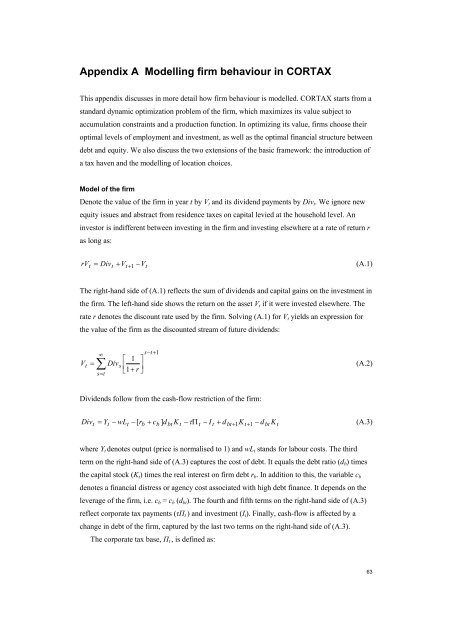The economic effects of EU-reforms in corporate income tax systems
The economic effects of EU-reforms in corporate income tax systems
The economic effects of EU-reforms in corporate income tax systems
Create successful ePaper yourself
Turn your PDF publications into a flip-book with our unique Google optimized e-Paper software.
Appendix A Modell<strong>in</strong>g firm behaviour <strong>in</strong> CORTAX<br />
This appendix discusses <strong>in</strong> more detail how firm behaviour is modelled. CORTAX starts from a<br />
standard dynamic optimization problem <strong>of</strong> the firm, which maximizes its value subject to<br />
accumulation constra<strong>in</strong>ts and a production function. In optimiz<strong>in</strong>g its value, firms choose their<br />
optimal levels <strong>of</strong> employment and <strong>in</strong>vestment, as well as the optimal f<strong>in</strong>ancial structure between<br />
debt and equity. We also discuss the two extensions <strong>of</strong> the basic framework: the <strong>in</strong>troduction <strong>of</strong><br />
a <strong>tax</strong> haven and the modell<strong>in</strong>g <strong>of</strong> location choices.<br />
Model <strong>of</strong> the firm<br />
Denote the value <strong>of</strong> the firm <strong>in</strong> year t by V t and its dividend payments by Div t . We ignore new<br />
equity issues and abstract from residence <strong>tax</strong>es on capital levied at the household level. An<br />
<strong>in</strong>vestor is <strong>in</strong>different between <strong>in</strong>vest<strong>in</strong>g <strong>in</strong> the firm and <strong>in</strong>vest<strong>in</strong>g elsewhere at a rate <strong>of</strong> return r<br />
as long as:<br />
rVt<br />
= +1 (A.1)<br />
Divt<br />
+ Vt<br />
−Vt<br />
<strong>The</strong> right-hand side <strong>of</strong> (A.1) reflects the sum <strong>of</strong> dividends and capital ga<strong>in</strong>s on the <strong>in</strong>vestment <strong>in</strong><br />
the firm. <strong>The</strong> left-hand side shows the return on the asset V t if it were <strong>in</strong>vested elsewhere. <strong>The</strong><br />
rate r denotes the discount rate used by the firm. Solv<strong>in</strong>g (A.1) for V t yields an expression for<br />
the value <strong>of</strong> the firm as the discounted stream <strong>of</strong> future dividends:<br />
∞<br />
s−t+<br />
1<br />
⎡ 1 ⎤<br />
V t = ∑ Divs<br />
⎢<br />
1<br />
⎥ (A.2)<br />
⎣ + r ⎦<br />
s=<br />
t<br />
Dividends follow from the cash-flow restriction <strong>of</strong> the firm:<br />
Div<br />
t<br />
= Yt<br />
− wLt<br />
− rb<br />
+ cb<br />
] dbt<br />
K t − Π t − I t + dbt+ 1Kt+<br />
1<br />
[ τ − d K<br />
(A.3)<br />
bt<br />
t<br />
where Y t denotes output (price is normalised to 1) and wL t stands for labour costs. <strong>The</strong> third<br />
term on the right-hand side <strong>of</strong> (A.3) captures the cost <strong>of</strong> debt. It equals the debt ratio (d b ) times<br />
the capital stock (K t ) times the real <strong>in</strong>terest on firm debt r b . In addition to this, the variable c b<br />
denotes a f<strong>in</strong>ancial distress or agency cost associated with high debt f<strong>in</strong>ance. It depends on the<br />
leverage <strong>of</strong> the firm, i.e. c b = c b (d bt ). <strong>The</strong> fourth and fifth terms on the right-hand side <strong>of</strong> (A.3)<br />
reflect <strong>corporate</strong> <strong>tax</strong> payments (τΠ t ) and <strong>in</strong>vestment (I t ). F<strong>in</strong>ally, cash-flow is affected by a<br />
change <strong>in</strong> debt <strong>of</strong> the firm, captured by the last two terms on the right-hand side <strong>of</strong> (A.3).<br />
<strong>The</strong> <strong>corporate</strong> <strong>tax</strong> base, Π t , is def<strong>in</strong>ed as:<br />
63
















